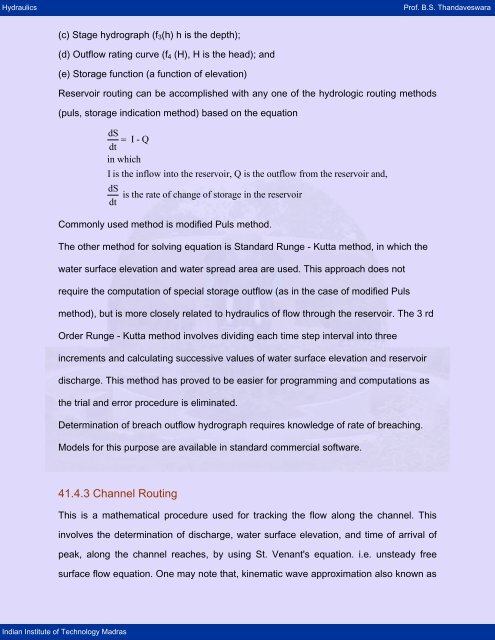41.4 Routing - nptel - Indian Institute of Technology Madras
41.4 Routing - nptel - Indian Institute of Technology Madras
41.4 Routing - nptel - Indian Institute of Technology Madras
You also want an ePaper? Increase the reach of your titles
YUMPU automatically turns print PDFs into web optimized ePapers that Google loves.
Hydraulics Pr<strong>of</strong>. B.S. Thandaveswara<br />
(c) Stage hydrograph (f3(h) h is the depth);<br />
(d) Outflow rating curve (f4 (H), H is the head); and<br />
(e) Storage function (a function <strong>of</strong> elevation)<br />
Reservoir routing can be accomplished with any one <strong>of</strong> the hydrologic routing methods<br />
(puls, storage indication method) based on the equation<br />
<strong>Indian</strong> <strong>Institute</strong> <strong>of</strong> <strong>Technology</strong> <strong>Madras</strong><br />
dS<br />
= I - Q<br />
dt<br />
in which<br />
I is the inflow into the reservoir, Q is the outflow from the reservoir and,<br />
dS is the rate <strong>of</strong> change <strong>of</strong> storage in the reservoir<br />
dt<br />
Commonly used method is modified Puls method.<br />
The other method for solving equation is Standard Runge - Kutta method, in which the<br />
water surface elevation and water spread area are used. This approach does not<br />
require the computation <strong>of</strong> special storage outflow (as in the case <strong>of</strong> modified Puls<br />
method), but is more closely related to hydraulics <strong>of</strong> flow through the reservoir. The 3 rd<br />
Order Runge - Kutta method involves dividing each time step interval into three<br />
increments and calculating successive values <strong>of</strong> water surface elevation and reservoir<br />
discharge. This method has proved to be easier for programming and computations as<br />
the trial and error procedure is eliminated.<br />
Determination <strong>of</strong> breach outflow hydrograph requires knowledge <strong>of</strong> rate <strong>of</strong> breaching.<br />
Models for this purpose are available in standard commercial s<strong>of</strong>tware.<br />
<strong>41.4</strong>.3 Channel <strong>Routing</strong><br />
This is a mathematical procedure used for tracking the flow along the channel. This<br />
involves the determination <strong>of</strong> discharge, water surface elevation, and time <strong>of</strong> arrival <strong>of</strong><br />
peak, along the channel reaches, by using St. Venant's equation. i.e. unsteady free<br />
surface flow equation. One may note that, kinematic wave approximation also known as
















